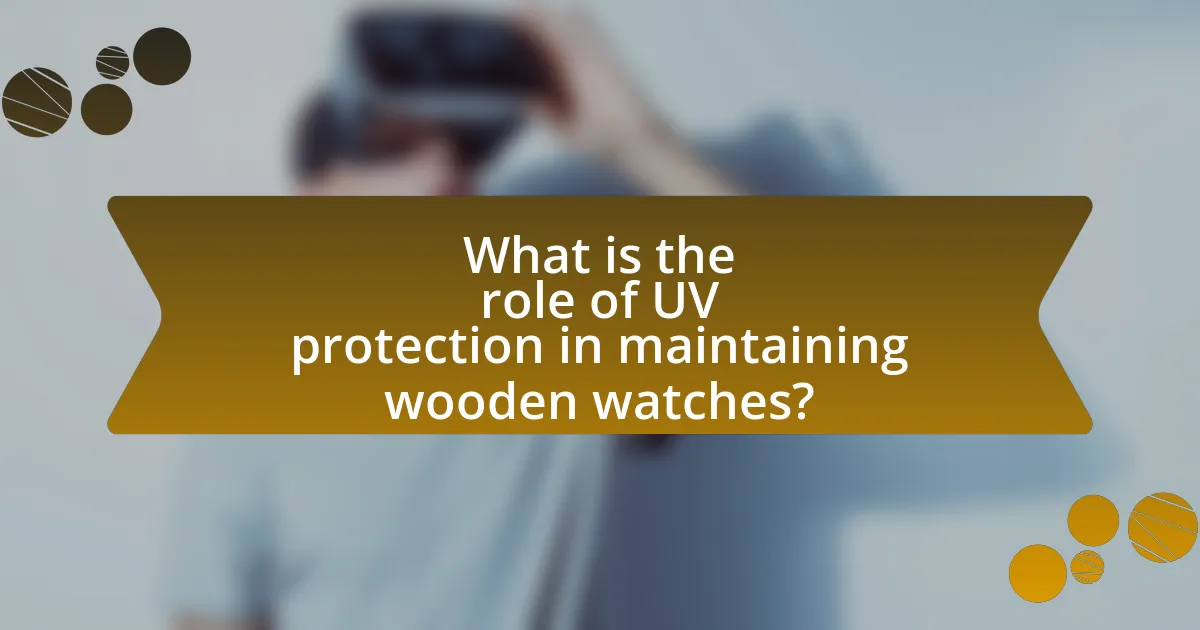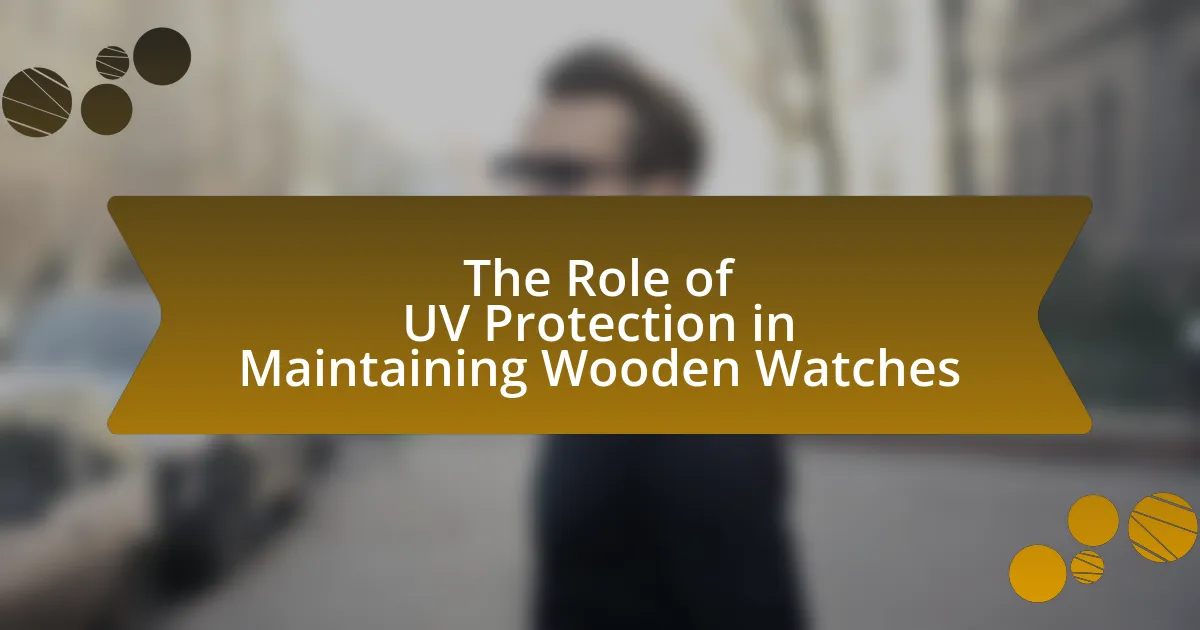The main entity of the article is UV protection and its significance in maintaining wooden watches. The article outlines how ultraviolet radiation can cause fading, discoloration, and degradation of wood, ultimately affecting the watch’s appearance and structural integrity. It discusses the importance of UV protection, the signs of UV damage, and various protective methods available, including UV-resistant coatings and natural oils. Additionally, the article addresses common misconceptions about UV protection, maintenance practices to enhance longevity, and recommended products for effective care of wooden watches.

What is the role of UV protection in maintaining wooden watches?
UV protection plays a crucial role in maintaining wooden watches by preventing damage from ultraviolet radiation, which can cause fading, discoloration, and degradation of the wood. Prolonged exposure to UV light can break down the natural oils and finishes applied to wooden watches, leading to a loss of luster and structural integrity. Studies have shown that UV rays can significantly accelerate the aging process of wood, making protective coatings essential for preserving the watch’s appearance and longevity.
Why is UV protection important for wooden watches?
UV protection is important for wooden watches because ultraviolet rays can cause significant damage to the wood, leading to discoloration, fading, and degradation of the material. Prolonged exposure to sunlight can break down the wood’s natural oils and resins, which are essential for maintaining its integrity and appearance. Studies have shown that UV radiation can accelerate the aging process of wood, resulting in a shorter lifespan for wooden watches if they are not adequately protected. Therefore, incorporating UV protection helps preserve the aesthetic and structural qualities of wooden watches, ensuring they remain functional and visually appealing over time.
How does UV exposure affect the wood in watches?
UV exposure causes wood in watches to degrade, leading to discoloration, loss of structural integrity, and potential cracking. Prolonged exposure to ultraviolet light breaks down the lignin in wood, which is essential for its strength and durability. Studies have shown that UV radiation can cause significant changes in the color and texture of wood, making it appear faded and worn over time. This degradation process can compromise the aesthetic and functional qualities of wooden watches, necessitating protective measures to preserve their appearance and longevity.
What are the signs of UV damage on wooden watches?
Signs of UV damage on wooden watches include discoloration, fading, and surface cracking. Discoloration manifests as a change in the wood’s natural hue, often resulting in a bleached appearance. Fading occurs when the vibrant colors of the wood diminish due to prolonged exposure to sunlight. Surface cracking can develop as the wood dries out and loses its moisture content, leading to structural integrity issues. These signs indicate that the watch has been subjected to harmful UV rays, which can degrade the wood over time.
What types of UV protection are available for wooden watches?
Wooden watches can be protected from UV damage through several methods, including UV-resistant coatings, natural oils, and specialized finishes. UV-resistant coatings, such as polyurethane or epoxy, create a barrier that reflects harmful UV rays, thereby preventing discoloration and degradation of the wood. Natural oils, like tung oil or linseed oil, can also provide a degree of UV protection while enhancing the wood’s appearance. Additionally, specialized finishes that incorporate UV inhibitors are designed specifically for wooden surfaces, offering long-lasting protection against sun exposure. These methods are effective in maintaining the integrity and aesthetic of wooden watches over time.
How do different UV coatings work on wooden surfaces?
Different UV coatings work on wooden surfaces by forming a protective layer that absorbs or reflects ultraviolet radiation, thereby preventing damage such as fading, discoloration, and degradation of the wood. These coatings can be categorized into several types, including oil-based, water-based, and polyurethane coatings, each offering varying degrees of UV protection. For instance, oil-based coatings penetrate the wood, providing a natural look while enhancing UV resistance, whereas water-based coatings dry quickly and emit fewer volatile organic compounds. Polyurethane coatings, known for their durability, create a hard film that effectively blocks UV rays. Research indicates that UV coatings can extend the lifespan of wooden surfaces by up to 50%, demonstrating their effectiveness in preserving the integrity and appearance of wood exposed to sunlight.
What are the pros and cons of using UV filters versus coatings?
Using UV filters provides the advantage of blocking harmful ultraviolet rays, which can prevent fading and degradation of wooden watches, while coatings offer a protective layer that enhances durability and water resistance. UV filters are typically easier to apply and can be replaced without affecting the underlying material, whereas coatings may require more complex application processes and can wear off over time, necessitating reapplication.
The effectiveness of UV filters is supported by studies showing that they can reduce UV exposure by up to 99%, significantly extending the lifespan of wooden materials. In contrast, coatings can provide additional benefits such as scratch resistance and improved aesthetics, but their longevity can vary based on environmental conditions and usage.
How can UV protection extend the lifespan of wooden watches?
UV protection can extend the lifespan of wooden watches by preventing damage caused by ultraviolet radiation, which can lead to fading, discoloration, and degradation of the wood. Prolonged exposure to UV light can break down the lignin in wood, weakening its structure and causing it to become brittle over time. By applying UV protective coatings or finishes, the wood is shielded from harmful rays, thereby preserving its natural color and integrity. Studies have shown that wood treated with UV protection can maintain its appearance and durability significantly longer than untreated wood, demonstrating the effectiveness of such protective measures in enhancing the longevity of wooden watches.
What maintenance practices enhance UV protection for wooden watches?
Regularly applying a UV-resistant wood finish enhances UV protection for wooden watches. This practice involves using specialized oils or sealants that contain UV inhibitors, which create a protective barrier against harmful sunlight. For instance, products like tung oil or marine varnish are known for their UV-blocking properties and can significantly prolong the lifespan of wooden materials exposed to sunlight. Additionally, storing wooden watches in a dark, cool place when not in use further minimizes UV exposure, thereby preserving the integrity of the wood.
How often should UV protection be reapplied or checked?
UV protection should be reapplied every two hours when exposed to direct sunlight. This frequency is recommended by dermatologists to ensure effective protection against harmful UV rays, which can cause damage to both skin and materials, including wooden watches. Regular checks should also be conducted to assess the condition of the UV protection, especially after swimming or sweating, as these activities can diminish its effectiveness.
What are the common misconceptions about UV protection in wooden watches?
Common misconceptions about UV protection in wooden watches include the belief that wood is inherently UV-resistant and that wooden watches do not require any additional UV protection. In reality, while some wood species have natural oils that provide limited UV resistance, prolonged exposure to sunlight can lead to fading, discoloration, and degradation of the wood. Additionally, many wooden watches are finished with coatings that may not offer adequate UV protection, making it essential for owners to apply UV-blocking treatments or store their watches away from direct sunlight to preserve their appearance and integrity.
Why do some people underestimate the need for UV protection?
Some people underestimate the need for UV protection due to a lack of awareness about the harmful effects of ultraviolet radiation on materials, including wood. Research indicates that UV rays can cause significant degradation in wooden products, leading to discoloration and structural damage over time. For instance, a study published in the Journal of Photochemistry and Photobiology found that prolonged exposure to UV light can result in the breakdown of lignin, a key component in wood, which compromises its integrity. This lack of understanding often leads individuals to neglect protective measures, ultimately affecting the longevity and appearance of wooden watches.
How can misinformation affect the care of wooden watches?
Misinformation can significantly impact the care of wooden watches by leading owners to neglect essential maintenance practices. For instance, incorrect beliefs about the durability of wood against UV exposure may result in inadequate protection measures, such as failing to store the watch away from direct sunlight. Research indicates that prolonged UV exposure can cause wood to fade and degrade, compromising the watch’s aesthetic and structural integrity. Therefore, understanding the correct care practices, including the necessity of UV protection, is crucial for preserving the longevity and functionality of wooden watches.
What practical tips can help maintain UV protection in wooden watches?
To maintain UV protection in wooden watches, regularly apply a UV-resistant wood finish or sealant specifically designed for wooden surfaces. This protective layer helps to shield the wood from harmful UV rays that can cause fading and degradation. Additionally, storing the watch in a shaded or dark place when not in use further reduces exposure to sunlight, thereby preserving its appearance and structural integrity. Regular maintenance, such as cleaning with a soft cloth and avoiding prolonged exposure to direct sunlight, also contributes to the longevity of the UV protection.
How should wooden watches be stored to minimize UV exposure?
Wooden watches should be stored in a dark, cool place to minimize UV exposure. This storage method protects the wood from fading and degrading, as prolonged exposure to UV light can cause discoloration and weaken the material. Using a protective case or box that blocks light can further enhance this protection, ensuring the longevity and aesthetic appeal of the watch.
What products are recommended for enhancing UV protection on wooden watches?
To enhance UV protection on wooden watches, products such as UV-resistant oils, varnishes, and specialized wood finishes are recommended. These products create a protective barrier that prevents UV rays from damaging the wood, which can lead to fading and deterioration. For instance, products containing UV inhibitors, like certain teak oils or marine varnishes, are specifically designed to shield wooden surfaces from harmful sunlight exposure, thereby extending the lifespan and appearance of the watch.
